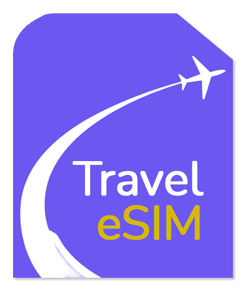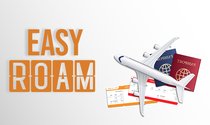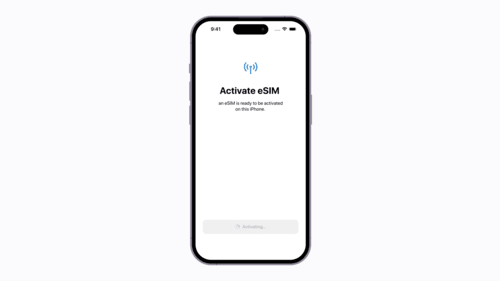Traditionally, travellers to Europe had to buy physical SIM cards to get high-speed mobile data during their trips. But if you have a newer phone, you might be in luck! Many recent models come equipped with an embedded eSIM, allowing you to connect to mobile networks without the hassle of swapping out physical SIM cards.
The Convenience and Quirks of eSIM Data Plans
While eSIM data plans offer unbeatable convenience for international travel, they do come with some quirks you should be aware of.
In this comprehensive guide, we’ll dive into everything you need to know about using eSIM data plans while travelling in Europe.
Here’s what we’ll cover:
- Why mobile data is essential for modern travel in Europe
- The pitfalls of relying on your home carrier’s international data plans
- What exactly an eSIM is, and how it works
- The benefits of using eSIM data plans for European travel
- Which phones are compatible with eSIMs
- The best eSIM data plans for different needs and budgets
- How to activate your eSIM plan and troubleshoot any issues
Do You Need Mobile Data in Europe?
Yes, of course.
Having reliable mobile data access is an essential part of any travel plan.
From digital tickets to online reservations, many aspects of modern European travel rely on having an internet connection at your fingertips.
7 Reasons Why Mobile Data is a Must-Have
Here are just a few of the many situations where mobile data comes in handy:
- Accessing digital train tickets: Many European rail systems now use mobile apps or e-tickets instead of physical copies.
- Navigating with Google Maps: With mobile data, you can easily find your way around unfamiliar cities and towns using GPS navigation.
- Displaying digital event tickets: Concerts, museums, and attractions often provide digital tickets that require an internet connection to access.
- Scanning restaurant menus via QR codes: Many European restaurants now use QR codes instead of physical menus, making mobile data a necessity for ordering.
- Using rideshare apps: Services like Uber and Bolt require a data connection to book rides and track your driver’s location.
- Making mobile payments at restaurants: More and more establishments are accepting mobile payments through apps like Apple Pay or Google Pay.
- Accessing real-time public transit information: Mobile data makes it easy to check bus and train schedules, delays, and route changes on the go.
Using Your Mobile Provider’s International Data Plan
If you’re considering using your current mobile provider’s international data plan while travelling in Europe, you might want to think twice.
While these plans offer the convenience of using your existing phone number and plan, they come with some significant drawbacks.
The High Costs of Provider Plans
Most US, Canadian, and Australian mobile providers offer international data plans, but they often come with excessively high pricing.
Here are some of the common issues you might encounter:
- Expensive daily rates: Many plans charge $10-20 per day for international data access, which can quickly add up over the course of your trip.
- Slow data speeds: Some providers throttle data speeds to 2G or 3G when roaming internationally, making it difficult to use data-heavy apps or services.
- Low data caps: Even with high daily rates, some plans have low data caps (often around 2GB) before they start throttling your speeds.
Why eSIM Is Better For Global Roaming Data?
When compared to prepaid eSIM data plans from third-party providers, these international plans from mobile carriers often cost 5 times more for the same amount of data.
In the next section, we’ll explore what an eSIM is and how it can provide a more affordable and flexible solution for staying connected in Europe.
What is an eSIM?
An eSIM, short for embedded SIM, is a digital version of the traditional physical SIM card that we’ve been using in our phones for years. Instead of having to swap out a tiny plastic card every time you want to change mobile providers, an eSIM allows you to connect to new networks through a simple app download.
The Perfect Travel Companion
This technology is particularly useful for international travel, as it enables you to easily switch between mobile providers without the hassle of hunting down a physical SIM card in a foreign country. Many newer smartphones, including iPhones and Android devices, now support dual SIM functionality, allowing you to use both a physical SIM and an eSIM simultaneously.
eSIM Compatibility: iPhones and Androids
If you’re an iPhone user, you’re in luck – most models released since 2019 have eSIM support. In fact, if you have a US iPhone 14 or newer, your device is eSIM-only and doesn’t even have a physical SIM slot. Some of the popular eSIM-compatible iPhone models include:
- iPhone XS, XS Max, and XR
- iPhone 11, 11 Pro, and 11 Pro Max
- iPhone 12, 12 Mini, 12 Pro, and 12 Pro Max
- iPhone 13, 13 Mini, 13 Pro, and 13 Pro Max
- iPhone 14, 14 Plus, 14 Pro, and 14 Pro Max
On the Android side, most devices sold since 2020 have eSIM support. Some popular eSIM-compatible Android phones include:
- Google Pixel 3a and newer
- Samsung Galaxy S20 and newer
- Samsung Galaxy Note 20 and newer
- Samsung Galaxy Z Flip and Z Fold series
With so many devices now supporting eSIM technology, it’s easier than ever to take advantage of its benefits for international travel. In the next section, we’ll explore those benefits in more detail.
For the latest eSIM compatible mobile devices please check this list.
Benefits of eSIM Mobile Data Plans
Now that you know what an eSIM is and which devices support it, let’s dive into the benefits of using eSIM mobile data plans for your European travel.
No More SIM Card Roulette
One of the biggest advantages of eSIM plans is that you no longer need to waste time searching for physical SIM cards in each country you visit. With an eSIM, you can pre-purchase your data plan and activate it via an app as soon as you arrive, saving you the hassle of tracking down a local mobile provider.
Instant Delivery and Dual SIM Functionality
Another benefit of eSIM plans is that they’re delivered instantly via email, with no shipping fees or delays. If your phone supports dual SIM functionality, you can even use your eSIM data plan alongside your existing physical SIM card. This allows you to:
Seamlessly switch between your domestic and travel plans as needed
Continue receiving important texts from your home number, such as two-factor authentication codes or fraud alerts
No Need to Remove Your Current SIM
With an eSIM, there’s no need to remove your current physical SIM card, which means you won’t risk losing it or damaging your phone’s SIM tray. Plus, many eSIM providers offer user-friendly apps that make it easy to add account credit or top up your data as needed.
A Smarter Way to Stay Connected
By choosing an eSIM data plan for your European adventure, you’ll enjoy:
- Convenience: No more swapping SIM cards or searching for Wi-Fi hotspots
- Flexibility: Choose the perfect plan for your needs and budget
- Affordability: Save money compared to traditional roaming or international plans
- Ease of use: Activate your plan and manage your account with just a few taps
Best eSIM Data Plans for Europe
After understanding why eSIM data plans are a game-changer for European travel, it’s time to explore the best options on the market. One key advantage is that EU regulations allow you to use data plans across all member countries, so you can enjoy seamless connectivity as you hop between destinations.
Major European Carriers for Reliable Coverage
While there are numerous eSIM providers to choose from, we recommend sticking with major European carriers for the best coverage and speeds during your trip. These larger networks typically offer more robust infrastructure and widespread availability, ensuring you stay connected even in remote areas.
It’s worth noting that the UK and Switzerland have some restrictions due to their non-EU membership, but most plans will still provide coverage in those countries with potential limitations.
Best eSIM Data Plan Picks
Here are some of the top eSIM data plans to consider for your European adventure:
- 1-100GB of data valid for up to 180 days
- 5G or 4G (lower speed where network not available)
- No hidden fees
Available regions:
Albania, Andorra, Austria, Belgium, Bulgaria, Croatia, Cyprus, Czech Republic, Denmark, Estonia, Finland, France, Germany, Gibraltar, Greece, Hungary, Iceland, Ireland, Italy, Latvia, Liechtenstein, Lithuania, Luxembourg, Malta, Montenegro, Netherlands, Norway, Poland, Portugal, Romania, Serbia, Slovakia, Slovenia, Spain, Sweden, Switzerland, Turkey, Ukraine, United Kingdom
- 1-50GB of data valid for up to 30 days
- 5G or 4G (lower speed where network not available)
- No hidden fees
Available Regions
Austria, Belgium, Bulgaria, Canary Islands, Croatia, Cyprus, Czech Republic, Denmark, Estonia, Finland, France, Germany, Greece, Hungary, Iceland, Ireland, Italy, Latvia, Liechtenstein, Lithuania, Luxembourg, Malta, Netherlands, Northern Cyprus, Norway, Poland, Portugal, Romania, Slovakia, Slovenia, Spain, Sweden, Switzerland, Turkey, United Kingdom, Vatican City
How Much Mobile Data is Needed in Europe?
Obviously, this will depend on your typical data usage but 500MB to 1GB per day is plenty for heavy data users i.e. social media, YouTube, and other streaming services.
If you’re just checking a few websites, social and email then a 300-500MB per day is fine.
Estimating Your Needs
To get a better idea of your potential data usage, consider the following:
- Trip length: The longer your trip, the more data you’ll likely need.
- Travel companions: If you’re travelling with others who will be using your hotspot or tethering, account for their data usage as well.
- Planned activities: Will you be attending events, visiting museums, or engaging in other data-heavy activities?
- Navigation needs: If you plan to rely heavily on GPS navigation, factor in additional data for mapping apps.
Once you have a rough estimate of your data needs, you can select an eSIM plan that aligns with your budget and usage requirements.
How to Activate an eSIM Data Plan
Activating your eSIM data plan is a straightforward process that can be completed in just a few simple steps. By following these guidelines, you’ll be able to set up your eSIM and start using your mobile data as soon as you arrive in Europe.
Step 1: Purchase Your eSIM Plan
Before embarking on your trip, purchase your chosen eSIM plan online. This will ensure that you have access to the necessary data and WiFi for the setup process. Upon completing your purchase, you’ll receive an email containing a unique QR code.
Step 2: Scan the QR Code
Using your phone’s camera or QR code scanner, scan the QR code from the email. This will prompt you to install the eSIM provider’s app on your device. Follow the on-screen instructions to download and install the app.
Step 3: Set Up Your eSIM Profile
Once the app is installed, open it and follow the provided directions to set up your eSIM profile. This process typically involves entering some basic information and confirming your plan details.
Step 4: Activate Your Plan
I recommend activating your eSIM the day you leave, or when you land, you’ll need to find a free WiFi service, of course.
Upon arrival, open the eSIM app and follow the prompts to activate your plan. Within a few moments, your phone should connect to the local network, and you’ll be ready to start using your mobile data.
Troubleshooting Tips
If you encounter any issues during the activation process, try the following:
- Double-check that your device is eSIM compatible
- Ensure you have a stable internet connection (WiFi or cellular data)
- Restart your device and attempt the activation again
- Contact the eSIM provider’s customer support for assistance
By following these simple steps, you’ll be able to quickly and easily set up your eSIM data plan, allowing you to stay connected throughout your European adventure.
Buying an eSIM in Europe
While purchasing an eSIM plan before your trip is the most convenient option, you may find yourself needing to buy one after arriving in Europe. The good news is that eSIMs can be purchased online from anywhere, as long as you have an internet connection.
Domestic Carrier Options
Each European country has its own domestic carriers that offer prepaid eSIM plans. However, it’s important to note that carrier-specific eSIM plans are not yet widely available at physical retailers. You may need to visit a carrier’s website or app to purchase an eSIM plan directly.
Additionally, many European carriers currently only offer postpaid eSIM plans, which require a longer-term commitment and may not be ideal for short-term visitors.
Sticking with Your Original Plan
Given the potential limitations of purchasing eSIMs from domestic carriers in Europe, we recommend sticking with one of the eSIM plans mentioned earlier in this article. These plans are specifically designed for travellers and offer the flexibility and convenience you need during your trip.
Country Compatibility Considerations
While not every European carrier offers eSIM plans, all countries in Europe support the technology. This means that, in most cases, you’ll be able to use your pre-purchased eSIM plan seamlessly across multiple countries.
However, there are a few exceptions to keep in mind:
Switzerland: As Switzerland is not part of the EU, some eSIM plans may not include coverage there. Be sure to check your plan’s specific country list before purchasing.
United Kingdom: Due to Brexit, there is a possibility of future restrictions on eSIM usage in the UK. As of now, most eSIM plans still include UK coverage, but it’s worth double-checking before you travel.
Additional Tips for Using eSIM Data Plans in Europe
To ensure you have the best possible experience using your eSIM data plan during your European travels, consider these additional tips and tricks:
Unlocked Phones and Compatibility
To use an eSIM plan, your phone must be unlocked and compatible with the eSIM technology. If you’re unsure whether your device is unlocked, contact your current carrier for assistance.
Battery Life and Portable Chargers
Using mobile data, especially for navigation and streaming, can quickly drain your phone’s battery. To avoid running out of power at inconvenient times, consider investing in a portable battery charger to keep your device topped up on the go.
Conserving Data with WiFi
To help conserve your mobile data, take advantage of WiFi hotspots whenever possible. Many hotels, cafes, and public spaces offer free WiFi, allowing you to save your data for when you’re out and about.
Managing Data Usage
To avoid accidentally consuming too much data, consider the following tips:
- Use airplane mode when you don’t need an internet connection to prevent background data usage.
- Disable automatic app updates and limit background data for data-hungry apps.
- Download offline maps for your destinations to use GPS navigation without consuming data.
- Use data compression tools or browsers to reduce the amount of data needed to load web pages.
Communicating with Locals
While many Europeans speak English, it’s always helpful to have a few key phrases in the local language. Consider using translation apps to help you communicate with locals when needed.
For making calls and sending texts, WhatsApp is a popular choice among Europeans. The app uses minimal data and can be a cost-effective way to stay in touch with both locals and loved ones back home.









